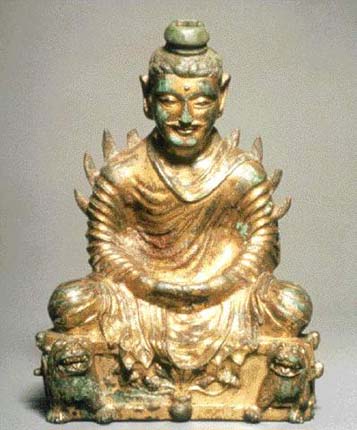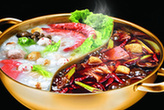Figures of the middle of the Wei Dynasty changed a lot in that Buddha's faces which once had been plump and decorous became fine and decated. In the late Northern Wei, Longmen style which laid stress on realness and meticulosity became the main stream in Buddhist figure carving. The works presented fine workmanship and a realistic approach. In the era of Xiaoming Emperor, this exciting artistic style was widely accepted as a rule for the then figure-carving craftsmen to follow.
Buddhist figures in Western Wei not only preserved the delicated and elegant bearings of Northern Wei but also were permeated with more artistic interest of life. The varied looks and unrestrained carriage were most fully displayed in the Grotto Temple on Maijishan Mountain.
 |
|
|
Figures in Northern Qi were known for changeable techniques of expression and characterization. The combination of Buddhas and their family dependents presented a colourful Buddhist world. More attention was paid to the sense of beauty against against the gorgeous back light.
Early arts of Buddhist images in the Sui Dynasty carried on part of the Northern Dynasty style. At its mature period of stone carving, Sui Dynasty produces many outstanding Buddhist statues with unique characteristics and dignified gestures and magnificent dress.
When it is the Tang Dynasty, Buddha images were dressed in clothes so thin and light as if wet gauze sticked to the body. The half-naked body was well-developed, assuming a projecting and clear arc line from breast to waist. This feature in curved body line became an important rule to judge carving works of Tang Dynasty from those of the others periods.
 |
|
|
Carved Buddha image works of the Song Dynasty were inferior to those in the Tang Dynasty in terms of number and scale. But new development was made to techniques of expression. Artists with superior skills characterized many figures with profound psychology and personality reflecting real life.
A broad review of China's carving arts of Buddhist figures showed that figures mainly followed the Indian styles at the beginning. The Northern and Southern Dynasties made some essential changes and improvements. China's first generation of Buddhist images with Han characteristics were thus created. Transforms of Bei Qi and the Sui Dynasty helped the Tang Dynasty creat a new peak of Buddhist figure carvings. This exotic art was finally localized and became popular. In the Song Dynasty, religious colour on Buddhist figures graduated faded and common delights of life were reflected. That is the main development of China's carving arts of Buddhist figures.
Source: Travel.ChinaVista.com
Editor: Liu Xiongfei





Why not rent a boyfriend, or girlfriend to please parents during the Spring Festival?